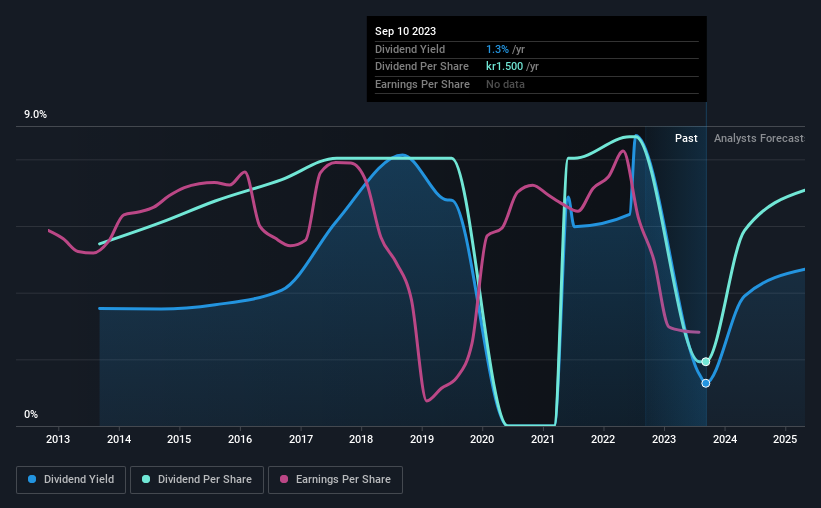Clas Ohlson AB (publ)'s (STO:CLAS B) dividend is being reduced from last year's payment covering the same period to SEK1.50 on the 15th of September. This means that the dividend yield is 1.3%, which is a bit low when comparing to other companies in the industry.
While the dividend yield is important for income investors, it is also important to consider any large share price moves, as this will generally outweigh any gains from distributions. Investors will be pleased to see that Clas Ohlson's stock price has increased by 51% in the last 3 months, which is good for shareholders and can also explain a decrease in the dividend yield.
See our latest analysis for Clas Ohlson
Clas Ohlson Doesn't Earn Enough To Cover Its Payments
The dividend yield is a little bit low, but sustainability of the payments is also an important part of evaluating an income stock. Prior to this announcement, Clas Ohlson's dividend was comfortably covered by both cash flow and earnings. This means that a large portion of its earnings are being retained to grow the business.
Earnings per share is forecast to rise by 49.1% over the next year. If the dividend continues on its recent course, the payout ratio in 12 months could be 194%, which is a bit high and could start applying pressure to the balance sheet.

Dividend Volatility
While the company has been paying a dividend for a long time, it has cut the dividend at least once in the last 10 years. The dividend has gone from an annual total of SEK4.25 in 2013 to the most recent total annual payment of SEK1.50. This works out to be a decline of approximately 9.9% per year over that time. A company that decreases its dividend over time generally isn't what we are looking for.
The Dividend Has Limited Growth Potential
Given that the track record hasn't been stellar, we really want to see earnings per share growing over time. Over the past five years, it looks as though Clas Ohlson's EPS has declined at around 11% a year. Dividend payments are likely to come under some pressure unless EPS can pull out of the nosedive it is in. However, the next year is actually looking up, with earnings set to rise. We would just wait until it becomes a pattern before getting too excited.
In Summary
Overall, the dividend looks like it may have been a bit high, which explains why it has now been cut. The payments haven't been particularly stable and we don't see huge growth potential, but with the dividend well covered by cash flows it could prove to be reliable over the short term. This company is not in the top tier of income providing stocks.
Companies possessing a stable dividend policy will likely enjoy greater investor interest than those suffering from a more inconsistent approach. However, there are other things to consider for investors when analysing stock performance. For example, we've picked out 2 warning signs for Clas Ohlson that investors should know about before committing capital to this stock. Is Clas Ohlson not quite the opportunity you were looking for? Why not check out our selection of top dividend stocks.
New: AI Stock Screener & Alerts
Our new AI Stock Screener scans the market every day to uncover opportunities.
• Dividend Powerhouses (3%+ Yield)
• Undervalued Small Caps with Insider Buying
• High growth Tech and AI Companies
Or build your own from over 50 metrics.
Have feedback on this article? Concerned about the content? Get in touch with us directly. Alternatively, email editorial-team (at) simplywallst.com.
This article by Simply Wall St is general in nature. We provide commentary based on historical data and analyst forecasts only using an unbiased methodology and our articles are not intended to be financial advice. It does not constitute a recommendation to buy or sell any stock, and does not take account of your objectives, or your financial situation. We aim to bring you long-term focused analysis driven by fundamental data. Note that our analysis may not factor in the latest price-sensitive company announcements or qualitative material. Simply Wall St has no position in any stocks mentioned.
About OM:CLAS B
Clas Ohlson
A retail company, sells building, electrical, multimedia, home, and leisure products in Sweden, Norway, Finland, and internationally.
Outstanding track record with flawless balance sheet and pays a dividend.
Similar Companies
Market Insights
Community Narratives




